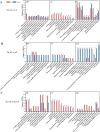Exogenous strigolactones alleviate low-temperature stress in peppers seedlings by reducing the degree of photoinhibition
- PMID: 39349999
- PMCID: PMC11441246
- DOI: 10.1186/s12870-024-05622-3
Exogenous strigolactones alleviate low-temperature stress in peppers seedlings by reducing the degree of photoinhibition
Abstract
Background: The growth and yield of pepper, a typical temperature-loving vegetable, are limited by low-temperature environments. Using low-temperature sensitive 'Hangjiao No. 4' (Capsicum annuum L.) as experimental material, this study analyzed the changes in plant growth and photosynthesis under different treatments: normal control (NT), low-temperature stress alone (LT), low-temperature stress in strigolactone pretreated plants (SL_LT), and low-temperature stress in strigolactone biosynthesis inhibitor pretreated plants (Tis_LT).
Results: SL pretreatment increased the net photosynthetic rate (Pn) and PSII actual photochemical efficiency (φPSII), reducing the inhibition of LT on the growth of pepper by 17.44% (dry weight of shoot). Due to promoting the accumulation of carotenoids, such as lutein, and the de-epoxidation of the xanthophyll cycle [(Z + A)/(Z + A + V)] by strigolactone after long-term low-temperature stress (120 h), non-photochemical quenching (NPQ) of pepper was increased to reduce the excess excitation energy [(1-qP)/NPQ] and the photoinhibition degree (Fv/Fm) of pepper seedlings under long-term low-temperature stress was alleviated. Twelve cDNA libraries were constructed from pepper leaves by transcriptome sequencing. There were 8776 differentially expressed genes (DEGs), including 4473 (51.0%) upregulated and 4303 (49.0%) downregulated genes. Gene ontology pathway annotation showed that based on LT, the DEGs of SL_LT and Tis_LT were significantly enriched in the cellular component, which is mainly related to the photosystem and thylakoids. Further analysis of the porphyrin and chlorophyll biosynthesis, carotenoid biosynthesis, photosynthesis-antenna protein, and photosynthetic metabolic pathways and the Calvin cycle under low-temperature stress highlighted 18, 15, 21, 29, and 31 DEGs for further study, which were almost all highly expressed under SL_LT treatment and moderately expressed under LT treatment, whereas Tis_LT showed low expression.
Conclusion: The positive regulatory effect of SLs on the low-temperature tolerance of pepper seedlings was confirmed. This study provided new insights for the development of temperature-tolerant pepper lines through breeding programs.
Keywords: Chilling stress; Pepper; Photosystem; RNA-seq; Strigolactones; Xanthophyll cycle.
© 2024. The Author(s).
Conflict of interest statement
The authors declare no competing interests.
Figures










Similar articles
-
Ameliorative effects of SL on tolerance to salt stress on pepper (Capsicum annuum L.) plants.Plant Physiol Biochem. 2025 Jun;223:109798. doi: 10.1016/j.plaphy.2025.109798. Epub 2025 Mar 20. Plant Physiol Biochem. 2025. PMID: 40147330
-
Mitigating effects of Methyl Jasmonate on photosynthetic inhibition and oxidative stress of pepper (Capsicum annuum L) seedlings under low temperature combined with low light.Plant Physiol Biochem. 2025 Jun;223:109843. doi: 10.1016/j.plaphy.2025.109843. Epub 2025 Mar 28. Plant Physiol Biochem. 2025. PMID: 40168861
-
Suppression Subtractive Hybridization Analysis of Genes Regulated by Application of Exogenous Abscisic Acid in Pepper Plant (Capsicum annuum L.) Leaves under Chilling Stress.PLoS One. 2013 Jun 18;8(6):e66667. doi: 10.1371/journal.pone.0066667. Print 2013. PLoS One. 2013. PMID: 23825555 Free PMC article.
-
Alleviating damage of photosystem and oxidative stress from chilling stress with exogenous zeaxanthin in pepper (Capsicum annuum L.) seedlings.Plant Physiol Biochem. 2021 May;162:395-409. doi: 10.1016/j.plaphy.2021.03.010. Epub 2021 Mar 9. Plant Physiol Biochem. 2021. PMID: 33740679
-
An integrative overview of cold response and regulatory pathways in horticultural crops.J Integr Plant Biol. 2025 Apr;67(4):1028-1059. doi: 10.1111/jipb.13903. Epub 2025 Apr 11. J Integr Plant Biol. 2025. PMID: 40213955 Review.
Cited by
-
Regulation of Exogenous Strigolactone on Storage Substance Metabolism and Endogenous Hormone Levels in the Early Germination Stage of Rice Seeds Under Salt Stress.Antioxidants (Basel). 2024 Dec 27;14(1):22. doi: 10.3390/antiox14010022. Antioxidants (Basel). 2024. PMID: 39857356 Free PMC article.
-
SL-6 Mimic Is a Biostimulant for Chlorella sorokiniana and Enhances the Plant Biostimulant Effect of Microalgal Extract.Plants (Basel). 2025 Mar 24;14(7):1010. doi: 10.3390/plants14071010. Plants (Basel). 2025. PMID: 40219078 Free PMC article.
-
Exogenous 24-Epibrassinolide Improves Low-Temperature Tolerance of Maize Seedlings by Influencing Sugar Signaling and Metabolism.Int J Mol Sci. 2025 Jan 11;26(2):585. doi: 10.3390/ijms26020585. Int J Mol Sci. 2025. PMID: 39859301 Free PMC article.
-
Genome-Wide identification and expression analysis of CsABF/AREB gene family in cucumber (Cucumis sativus L.) and in response to phytohormonal and abiotic stresses.Sci Rep. 2025 May 6;15(1):15757. doi: 10.1038/s41598-025-00706-y. Sci Rep. 2025. PMID: 40328839 Free PMC article.
-
Responses of Tomato Photosystem II Photochemistry to Pegylated Zinc-Doped Ferrite Nanoparticles.Nanomaterials (Basel). 2025 Feb 13;15(4):288. doi: 10.3390/nano15040288. Nanomaterials (Basel). 2025. PMID: 39997850 Free PMC article.
References
-
- John R, Anjum NA, Sopory SK, Akram NA, Ashraf M. Some key physiological and molecular processes of cold acclimation. Biol Plant. 2016;60:603–18.
-
- Li J, Yang P, Gan Y, Yu J, Xie J. Brassinosteroid alleviates chilling-induced oxidative stress in pepper by enhancing antioxidation systems and maintenance of photosystem II. Acta Physiol Plant. 2015;(37):1–11.
-
- Korkmaz A, Korkmaz Y, Demirkıran AR. Enhancing chilling stress tolerance of pepper seedlings by exogenous application of 5-aminolevulinic acid. Environ Exp Bot. 2010;67(3):495–501.
-
- Al-Babili S, Bouwmeester HJ. Strigolactones, a novel carotenoid-derived plant hormone. Annu Rev Plant Biol. 2015;66:161–86. - PubMed
MeSH terms
Substances
Grants and funding
LinkOut - more resources
Full Text Sources
Research Materials

